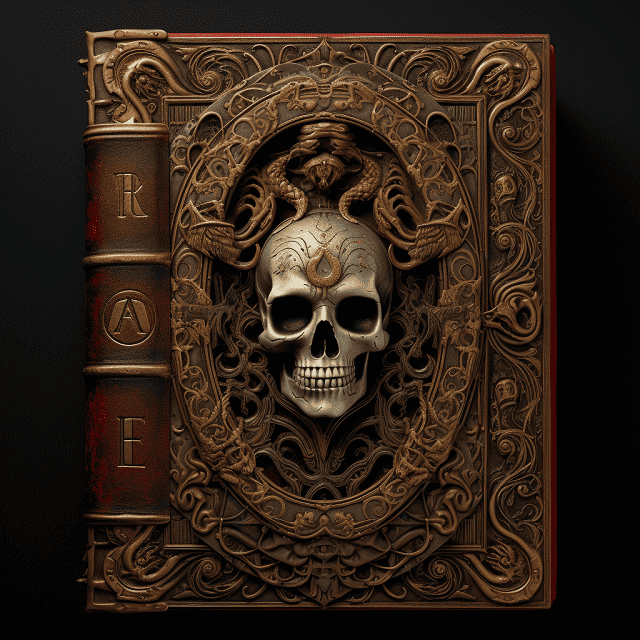Dive into the depths of the ancient Egyptian underworld with us. You’re about to uncover the untold truths behind the Book of the Dead. This isn’t just a dusty old tome; it’s a guidebook for the afterlife, packed with spells and incantations. We’ll delve into its origins, its role, and its lasting impact on our understanding of Egyptian beliefs. Ready? Let’s unravel the mysteries of the Book of the Dead together.
Understanding the Origin of the Book of The Dead
You’re about to delve into the fascinating origins of the Book of The Dead, a crucial piece of ancient Egyptian culture. This sacred text was not a single book but rather a collection of spells and illustrations. It was believed to guide the deceased through the underworld and into the afterlife. The origins of the Book of The Dead trace back to the Pyramid Texts of the Old Kingdom (circa 2686 – 2181 BCE), making it one of the oldest religious texts in the world.
The Pyramid Texts were inscriptions carved onto the walls of the burial chambers inside pyramids. They were exclusively for the pharaohs and their consorts, ensuring they’d overcome the challenges of the afterlife and attain immortality. During the Middle Kingdom (circa 2050-1700 BCE), these texts evolved into the Coffin Texts, which were painted or inscribed onto the coffins of non-royal individuals. This shift indicated that the promise of the afterlife was now accessible to everyone, not just the royalty.
The New Kingdom (circa 1550 – 1070 BCE) saw the emergence of the Book of The Dead as we know it. The spells and illustrations were now written on papyrus scrolls and placed in the tombs of the deceased. Each Book of The Dead was unique, tailored to the individual’s status and wealth. This evolution underscores the democratization of the afterlife in ancient Egyptian beliefs. The Book of The Dead, therefore, is more than a historical artifact; it’s a testament to the evolving religious and social structures of ancient Egypt.
The Role of the Book of The Dead in Ancient Egyptian Society
In ancient Egyptian society, you’d find this text essential for guiding the deceased through the afterlife. The Book of the Dead, a compilation of spells, prayers, and incantations, played a crucial role in the spiritual journey of the departed soul. It was believed to provide the necessary knowledge and power to navigate the complex realm of the afterlife.
- Guide to the Afterlife: The Book of the Dead served as a roadmap for the departed soul. Its spells were designed to overcome obstacles, defeat dangerous creatures, and sway the judgement of the gods in the favor of the deceased. You’d consider this text a spiritual GPS to the eternal life.
- Ritual Significance: The Book of the Dead wasn’t just a guide, it was also used in funerary rites. Priests would recite spells from the book during the mummification process and burial ceremonies, invoking the gods to grant safe passage and accept the deceased into the afterlife.
- Symbol of Social Status: Possession of a personalized copy of the Book of the Dead signified wealth and status. While initially reserved for royalty, over time, the demand for these texts expanded to include nobles and eventually, anyone who could afford one. So, having this text was a sign of your place in ancient Egyptian society.
The Contents and Structure of the Book of The Dead
Diving deeper into its contents and structure, you’ll discover that this ancient text isn’t just a random collection of spells, but a meticulously organized guide, reflecting the Egyptians’ detailed vision of the afterlife. While the Book of the Dead isn’t uniform across all periods and individuals, it generally contains three key divisions, each focusing on a distinct aspect of the afterlife journey.
The first part prepares the deceased for their journey to the afterlife. The second part ensures the deceased’s successful judgment before Osiris, the god of the afterlife. The third part offers guidance on how to sustain life in the afterworld.
These divisions are further highlighted below:
| Division | Description | Example Spell |
|---|---|---|
| Preparation for Journey | Spells and hymns for protection and guidance | Spell 17: For knowledge of the paths of the Duat |
| Judgement Before Osiris | Spells to ensure a favourable judgement | Spell 125: The Negative Confessions |
| Life in the Afterworld | Spells for sustenance and protection in the hereafter | Spell 110: For becoming a god in the realm of the dead |
Each spell within the divisions was designed to equip the deceased with the necessary spiritual tools to navigate the complex afterlife. Some spells offer protection against dangerous creatures, while others ensure successful rebirth. The Book of the Dead’s structure, therefore, is less about a sequence of events and more about providing a comprehensive ‘manual’ for the afterlife. It’s a fascinating testament to how the ancient Egyptians perceived life, death, and what potentially lay beyond.

The Ritualistic Use of the Book of The Dead in Funerals
When it comes to the rituals of ancient Egyptian funerals, you’ll find that this sacred text played a significant role. The Book of the Dead wasn’t just a guide to the afterlife, but a crucial component of the funeral rites. It served as a comforting presence, a guide, and a tool for the deceased to navigate the challenges of the afterlife.
The Book of the Dead was used in three main ways:
- Ritualistic Reading: Priests would read aloud certain spells from the Book of the Dead during the funeral rites. This was done to activate the magic within the text, ensuring the deceased’s safe passage to the afterlife.
- Tomb Decoration: The walls of the tombs were often adorned with excerpts from the Book. These inscriptions weren’t just decorative; they served a spiritual purpose. The tomb became a sacred space, filled with protective spells.
- Personal Burial Item: Copies of the Book of the Dead were often buried with the deceased. This was the deceased’s personal guide to the afterlife, providing them with the necessary spells to overcome the trials they’d face.
Decoding the Spells and Incantations in the Book of The Dead
You’ll find that decoding the spells and incantations can shed light on the ancient Egyptian’s beliefs about death and the afterlife. Each spell in the Book of the Dead served a distinct purpose, carefully crafted to guide the deceased through the perilous journey to the afterlife.
Consider the following examples:
| Spell Number | Purpose |
|---|---|
| Spell 125 | Judgement of the deceased in the Hall of Maat |
| Spell 17 | Detailed description of the creation of the world |
| Spell 30B | Prevents the heart from speaking against the deceased in the afterlife |
| Spell 6 | Ensures the continued existence of the deceased in the afterlife |
Spell 125, for instance, outlines the ‘negative confession’, a list of sins the deceased must declare they did not commit in their lifetime. This shows the importance of moral conduct in ancient Egyptian beliefs.
Spell 17 provides an intricate account of the world’s creation, reinforcing their cosmological views. The deceased’s heart, considered the seat of the soul and morality, was of particular importance in the afterlife; hence, Spell 30B was included to prevent it from betraying its owner during judgment.
Finally, Spell 6, underscoring the necessity of continued existence in the afterlife, reflects the ancient Egyptians’ firm belief in life beyond death. Through this spell, it’s clear that the afterlife was not perceived as an end, but a continuation of life.
Therefore, by decoding these spells, you’re not just understanding ancient texts; you’re uncovering the spiritual, ethical, and cosmological beliefs that defined the ancient Egyptians’ view of death and the afterlife.

The Impact of the Book of The Dead on Modern Understanding of Egyptian Afterlife Beliefs
Through the study of this ancient guide, you’re able to grasp a deeper understanding of how the Egyptians perceived life after death. The Book of the Dead, previously deciphered in our last discussion, illuminates three key concepts about the Egyptian afterlife:
- Judgment after Death: Egyptians believed in the judgment of the soul after death. The Book of the Dead offers detailed accounts of this process, detailing how the heart of the deceased would be weighed against the feather of Ma’at, symbolizing truth and justice.
- The Journey of the Soul: This text outlines a complex journey the soul undertakes after death, navigating through various realms and overcoming challenges with the help of spells and incantations. This shows that the Egyptians believed in the continuation of the soul beyond physical existence.
- Interactions with Deities: The book includes numerous prayers and invocations to various deities, underscoring the importance of divine intercession in the journey of the soul.

Frequently Asked Questions
How Did the Ancient Egyptians Create the Physical Book of the Dead?
You’re wondering about the creation of the ancient Egyptian Book of the Dead. They’d first flatten and smooth papyrus reeds, forming a type of paper. Scribes then used a stylus to carefully inscribe hieroglyphs onto the papyrus. These writings were spells and instructions intended to guide the deceased in the afterlife. Finally, the papyrus sheets were compiled and bound to create the book. Each book was unique, tailored to the individual it was made for.
Were There Any Punishments or Consequences for Incorrectly Using the Book of the Dead in Ancient Egypt?
Imagine the unimaginable consequences of misusing the Book of the Dead in ancient Egypt. There’s no historical evidence of specific punishments. However, as the book was considered sacred, it’s likely any misuse could result in harsh penalties, perhaps even death. The Egyptians believed in the power of this text to affect the afterlife; any disrespect could have been seen as disrupting the natural order. So, you’d want to use it correctly!
Can the Book of the Dead Be Compared to Any Religious Texts in Modern Societies?
Yes, you can compare the Book of the Dead to modern religious texts. It’s much like the Christian Bible or the Hindu Vedas, serving as a guide for the afterlife. However, it’s unique because it wasn’t standardized. Each copy was individually made for the deceased, filled with spells and instructions tailored to their needs, making it a highly personalized religious text, unlike uniform modern scriptures.
Have Any Complete Copies of the Book of the Dead Been Discovered in Recent Archaeological Excavations?
Yes, complete copies of the Book of the Dead have been discovered in recent archaeological digs. You’d be fascinated to know that one of the most intact versions was found in the tomb of Tutankhamun. This remarkable find provides invaluable insights into ancient Egyptian beliefs and rituals. It’s like stepping back in time, immersing yourself in their world. Don’t you just love how archaeology unveils hidden treasures of our past?
How Has the Book of the Dead Influenced Modern Depictions of the Ancient Egyptian Culture in Popular Media?
You’ve likely seen modern media’s depiction of Ancient Egypt’s culture influenced by the Book of the Dead. This ancient text has shaped our understanding of their beliefs about the afterlife. It’s often used in films, literature, and games to add depth and authenticity. You’ll notice it in the mystical rituals, elaborate burial practices, and journeying souls prevalent in these works. Therefore, the Book of the Dead has significantly shaped how we portray Ancient Egypt today.
Conclusion
So, you’ve journeyed through the sacred pages of the Egyptian Book of the Dead – a guidebook for the afterlife. You’ve peered into the intimate rituals, deciphered ancient spells, and ventured into the heart of Egyptian beliefs. It’s more than a historical document; it’s a profound reflection of our human quest for immortality. Truly, this book is a lasting testament to the timeless fascination and mystery of the human journey beyond death.

